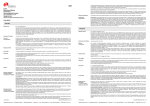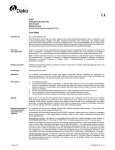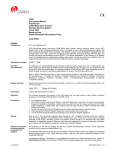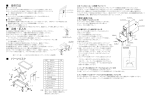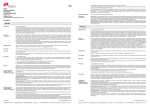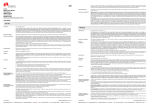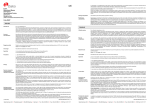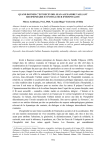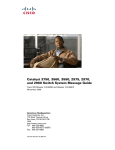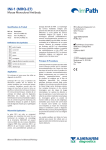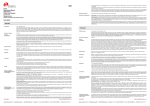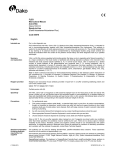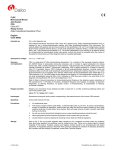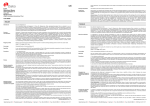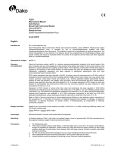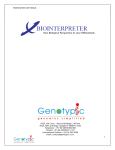Download FLEX Monoclonal Mouse Anti-Human CD57 Clone TB01
Transcript
for information on re-programming of the protocol. Verify that the performance of the adjusted protocol is still valid by evaluating that the staining pattern is identical to the staining pattern described in “Performance characteristics”. Counterstaining in hematoxylin is recommended using EnVision FLEX Hematoxylin, (Dako Autostainer/Autostainer Plus) (Code K8018). Non-aqueous, permanent mounting medium is recommended. Positive and negative controls should be run simultaneously using the same protocol as the patient specimens. The positive control tissue should include tonsil and colon/appendix and the cells/structures should display reaction patterns as described for this tissue in “Performance characteristics” in all positive specimens. The recommended negative control reagent is FLEX Negative Control, Mouse, (Dako Autostainer/Autostainer Plus) (Code IS750). FLEX Monoclonal Mouse Anti-Human CD57 Clone TB01 Ready-to-Use (Dako Autostainer/Autostainer Plus) Code IS647 Staining interpretation Cells labeled by the antibody display cytoplasmic and/or membrane staining. Performance characteristics Normal tissues: NK/T cells in the T-zone of the tonsil and at the edge of germinal centers show a moderate to strong staining reaction, whereas Schwann cells in i.e. Auerbach’s and Meissner’s plexus in colon/appendix show a weak to moderate staining reaction. In liver, the antibody labels lymphocytes but not liver cells. In colon only a few lymphocytes in addition to nerve fibers are labeled. In brain, the antibody labels all cells, except endothelial cells. The antibody labels epithelial cells in breast and prostatic tissue. In pancreas, the antibody labels more than 50% of islet cells. Skin and placenta show no labeling. Abnormal tissues: The antibody labeled 8/8 astrocytomas, 3/3 intestinal carcinoid tumours, 2/2 ependymomas, 1/1 oligodendroglioma, 1/1 nonsmall cell lung carcinoma, 4/14 ductal mamma carcinomas, and 4/16 lobular mamma carcinomas. ENGLISH Intended use For in vitro diagnostic use. FLEX Monoclonal Mouse Anti-Human CD57, Clone TB01, Ready-to-Use, (Dako Autostainer/Autostainer Plus), is intended for use in immunohistochemistry together with Dako Autostainer/Autostainer Plus instruments. Antibodies to CD57 may be useful for the identification of T-cell large granular lymphocyte disorders, oligodendrogliomas and neuroendocrine tumors, and assist in the identification of lymphocytic and histiocytic (L&H) cells of lymphocyte-predominant Hodgkin’s disease (1). The clinical interpretation of any staining or its absence should be complemented by morphological studies using proper controls and should be evaluated within the context of the patient's clinical history and other diagnostic tests by a qualified pathologist. Synonym for antigen HNK-1 (2-4). Summary and explanation The CD57 molecule, originally described as the HNK-1 antigen, is a marker characteristic of both haemopoietic and neuroectodermal-derived cells (2-4). It is a glycoprotein of 110-115 kDa with variable levels of carbohydrate, which may account for variations in the molecular weight (2, 4). CD57 is present on NK cells, on a subset of CD8-positive lymphocytes, and on a small percentage of CD4-positive/CD45R0-positive T lymphocytes located in the germinal centres of tonsils and lymph nodes (1, 3, 4). It is present in a number of liver-associated lymphocytes (4), and the expression increases with age in peripheral blood lymphocytes (1, 4). The number of CD57-positive cells increases also in pathologies characterized by an imbalance of CD4/CD8 lymphocytes, e.g. AIDS, autoimmune diseases, allograft transplants, viral infections, and colorectal cancer-infiltrating lymphocytes (1, 3, 4). Normal neuroectodermal cells and striated muscle as well as their neoplastic counterparts also express CD57 (1, 3, 4). Furthermore, CD57 is expressed by normal and neoplastic prostatic epithelia (1, 4). Refer to Dako’s General Instructions for Immunohistochemical Staining or the detection system instructions of IHC procedures for: 1) Principle of Procedure, 2) Materials Required, Not Supplied, 3) Storage, 4) Specimen Preparation Reagent provided Ready-to-use monoclonal mouse antibody provided in liquid form in a buffer containing stabilizing protein and 0.015 mol/L sodium azide. Clone: TB01 (2-4). Isotype: IgM, kappa. Immunogen A pool of neuroblastoma cell lines (2). Specificity Anti-Human CD57, Clone TB01, was clustered as anti-CD57 at the 6th International Workshop and Conference on Human Leucocyte Differentiation Antigens (4). In immunocytochemistry, the antibody labels T-cells in unfixed human endometrial tissue (5). The epitope defined by Anti-Human CD57, Clone TB01, is neuraminidase- and bromelain-sensitive but trypsin-resistant (2). Precautions 1. For professional users. 2. This product contains sodium azide (NaN3), a chemical highly toxic in pure form. At product concentrations, though not classified as hazardous, sodium azide may react with lead and copper plumbing to form highly explosive build-ups of metal azides. Upon disposal, flush with large volumes of water to prevent metal azide build-up in plumbing. 3. As with any product derived from biological sources, proper handling procedures should be used. 4. Wear appropriate Personal Protective Equipment to avoid contact with eyes and skin. 5. Unused solution should be disposed of according to local, State and Federal regulations. Storage Store at 2-8 °C. Do not use after expiration date sta mped on vial. If reagents are stored under any conditions other than those specified, the conditions must be verified by the user. There are no obvious signs to indicate instability of this product. Therefore, positive and negative controls should be run simultaneously with patient specimens. If unexpected staining is observed which cannot be explained by variations in laboratory procedures and a problem with the antibody is suspected, contact Dako Technical Support. Specimen preparation including materials required but not supplied FRANÇAIS Utilisation prévue Pour utilisation lors d’un diagnostic in vitro. FLEX Monoclonal Mouse Anti-Human CD57, Clone TB01, Ready-to-Use, (Dako Autostainer/Autostainer Plus), est destiné à une utilisation en immunohistochimie avec les instruments Dako Autostainer/Autostainer Plus. Les anticorps anti-CD57 peuvent être utiles pour l’identification des troubles à grands lymphocytes granuleux T, les oligodendrogliomes et les tumeurs neuroendocriniennes et pour aider à l’identification des cellules lymphocytaires et histiocytaires (L et H) de la maladie de Hodgkin à prédominance lymphocytaire (1). L’interprétation clinique de toute coloration ou son absence doit être complétée par des études morphologiques en utilisant des contrôles appropriés et doit être évaluée en fonction des antécédents cliniques du patient et d’autres tests diagnostiques par un pathologiste qualifié. Synonyme de l’antigène HNK-1 (2–4). Résumé et explication La molécule CD57, décrite initialement comme l’antigène HNK-1, est un marqueur caractéristique des cellules hématopoïétiques et des cellules dérivées du neuroectoderme (2–4). C’est une glycoprotéine de 110 à 115 kDa avec des niveaux variables d’hydrates de carbone, qui peuvent entraîner des variations dans le poids moléculaire (2,4). La CD57 est présente sur les cellules NK, sur un sous-ensemble de lymphocytes positifs au CD-8 et sur un petit pourcentage de lymphocytes T positifs aux CD4/CD45R0, situés sur les centres germinatifs des amygdales et des ganglions lymphatiques (1, 3, 4). Elle est présente dans un certain nombre de lymphocytes associés au foie (4), et l’expression augmente avec l’âge dans les lymphocytes du sang périphérique (1, 4). Le nombre de cellules positives à la CD57 augmente aussi dans les pathologies caractérisées par un déséquilibre des lymphocytes CD4/CD8, p.ex., le sida, les troubles auto-immuns, les allogreffes, les infections virales et les lymphocytes infiltrant une tumeur colorectale (1, 3, 4). Les cellules neuroectodermiques normales, le muscle strié et leurs contreparties néoplasiques expriment également la CD57 (1, 3, 4). De plus, la CD57 est exprimée par les épithéliums prostatiques normaux et néoplasiques (1, 4). Se référer aux Instructions générales de coloration immunohistochimique de Dako ou aux instructions du système de détection relatives aux procédures IHC pour plus d’informations concernant les points suivants : 1) Principe de procédure, 2) Matériels requis mais non fournis, 3) Conservation, 4) Préparation des échantillons, 5) Procédure de coloration, 6) Contrôle qualité, 7) Dépannage, 8) Interprétation de la coloration, 9) Limites générales. Réactifs fournis Anticorps monoclonal de souris prêt à l’emploi fourni sous forme liquide dans un tampon contenant une protéine stabilisante et 0,015 mol/L d’azide de sodium. Clone : TB01 (2–4). Isotype : IgM, kappa. Immunogène Un groupe de lignées cellulaires de neuroblastome (2). Spécificité Le Anti-Human CD57, clone TB01, a été classé comme un anti-CD57 à la 6th International Workshop and Conference on Human Leucocyte Differentiation Antigens (Sixième Conférence et Atelier Internationaux sur les Antigènes de Différenciation des Leucocytes Humains) (4). En immunocytochimie, l’anticorps marque les lymphocytes T dans le tissu endométrial humain non fixé (5). L’épitope défini par l’Anti-Human CD57, clone TB01, est sensible à la neuraminidase et à la bromélaïne mais résistant à la trypsine (2). Précautions 1. Pour utilisateurs professionnels. 2. Ce produit contient de l’azide de sodium (NaN3), produit chimique hautement toxique dans sa forme pure. Aux concentrations du produit, bien que non classé comme dangereux, l’azide de sodium peut réagir avec le cuivre et le plomb des canalisations et former des accumulations d’azides métalliques hautement explosifs. Lors de l’élimination, rincer abondamment à l’eau pour éviter toute accumulation d’azide métallique dans les canalisations. 3. Comme avec tout produit d’origine biologique, des procédures de manipulation appropriées doivent être respectées. 4. Porter un vêtement de protection approprié pour éviter le contact avec les yeux et la peau. 5. Les solutions non utilisées doivent être éliminées conformément aux réglementations locales et nationales. Conservation Conserver entre 2 et 8 °C. Ne pas utiliser après la date de péremption indiquée sur le flacon. Si les réactifs sont conservés dans des conditions autres que celles indiquées, celles-ci doivent être validées par l’utilisateur. Il n’y a aucun signe évident indiquant l’instabilité de ce produit. Par conséquent, des contrôles positifs et négatifs doivent être testés en même temps que les échantillons de patient. Si une coloration inattendue est observée, qui ne peut être expliquée par un changement des procédures du laboratoire, et en cas de suspicion d’un problème lié à l’anticorps, contacter l’assistance technique de Dako. Préparation des échantillons y compris le matériel requis mais non fourni L’anticorps peut être utilisé pour le marquage des coupes de tissus inclus en paraffine et fixés au formol. L’épaisseur des coupes d’échantillons de tissu doit être d’environ 4 µm. The antibody can be used for labeling formalin-fixed, paraffin-embedded tissue sections. Tissue specimens should be cut into sections of approximately 4 µm. Pre-treatment with heat-induced epitope retrieval (HIER) is required using Dako PT Link (Code PT100/PT101). For details, please refer to the PT Link User Guide. Optimal results are obtained by pretreating tissues using EnVision FLEX Target Retrieval Solution, High pH (50x) (Code K8010/K8004). Paraffin-embedded sections: Pre-treatment of formalin-fixed, paraffin-embedded tissue sections is recommended using the 3-in-1 specimen preparation procedure for Dako PT Link. Follow the pre-treatment procedure outlined in the package insert for EnVision FLEX Target Retrieval Solution, High pH (50x) (Code K8010/K8004). Note: After staining the sections must be dehydrated, cleared and mounted using permanent mounting medium. Deparaffinized sections: Pre-treatment of deparaffinized formalin-fixed, paraffin-embedded tissue sections is recommended using Dako PT Link and following the same procedure as described for paraffin-embedded sections. After staining the slides should be mounted using aqueous or permanent mounting medium. The tissue sections should not dry out during the treatment or during the following immunohistochemical staining procedure. For greater adherence of tissue sections to glass slides, the use of FLEX IHC Microscope Slides (Code K8020) is recommended. Staining procedure including materials required but not supplied The recommended visualization system is EnVision FLEX, High pH, (Dako Autostainer/Autostainer Plus) (Code K8010). The staining steps and incubation times are pre-programmed into the software of Dako Autostainer/Autostainer Plus instruments, using the following protocols: Template protocol: FLEXRTU2 (200 µL dispense volume) or FLEXRTU3 (300 µL dispense volume) Autoprogram: CD57 (without counterstaining) or CD57H (with counterstaining) Coupes incluses en paraffine : le prétraitement des coupes tissulaires fixées au formol et incluses en paraffine est recommandé à l'aide de la procédure de préparation d'échantillon 3-en-un pour le Dako PT Link. Suivre la procédure de prétraitement indiquée dans la notice de la EnVision FLEX Target Retrieval Solution, High pH (50x) (Réf. K8010/K8004). Remarque : après coloration, les coupes doivent être déshydratées, lavées et montées à l’aide d’un milieu de montage permanent. The Auxiliary step should be set to “rinse buffer” in staining runs with ≤10 slides. For staining runs with >10 slides the Auxiliary step should be set to “none”. This ascertains comparable wash times. All incubation steps should be performed at room temperature. For details, please refer to the Operator’s Manual for the dedicated instrument. If the protocols are not available on the used Dako Autostainer instrument, please contact Dako Technical Services. Optimal conditions may vary depending on specimen and preparation methods, and should be determined by each individual laboratory. If the evaluating pathologist should desire a different staining intensity, a Dako Application Specialist/Technical Service Specialist can be contacted (117049-002) Dako Denmark A/S IS647/EFG/MNI/2009.12.04 p. 1/4 | Produktionsvej 42 | DK-2600 Glostrup | Denmark | Tel. +45 44 85 95 00 | Fax +45 44 85 95 95 | CVR No. 33 21 13 17 Un prétraitement avec démasquage d’épitope induit par la chaleur (HIER) est nécessaire avec le Dako PT Link (Réf. PT100/PT101). Pour plus de détails, se référer au Guide d’utilisation du PT Link. Des résultats optimaux sont obtenus en prétraitant les tissus à l’aide de la EnVision FLEX Target Retrieval Solution, High pH (50x) (Réf. K8010/K8004). Coupes déparaffinées : le prétraitement des coupes tissulaires déparaffinées, fixées au formol et incluses en paraffine, est recommandé à l’aide du Dako PT Link, en suivant la même procédure que pour les coupes incluses en paraffine. Après coloration, un montage aqueux ou permanent des lames est recommandé. Les coupes de tissus ne doivent pas sécher lors du traitement ni lors de la procédure de coloration immunohistochimique suivante. Pour une (117049-002) Dako Denmark A/S IS647/EFG/MNI/2009.12.04 p. 2/4 | Produktionsvej 42 | DK-2600 Glostrup | Denmark | Tel. +45 44 85 95 00 | Fax +45 44 85 95 95 | CVR No. 33 21 13 17 meilleure adhérence des coupes de tissus sur les lames de verre, il est recommandé d’utiliser des lames FLEX IHC Microscope Slides (Réf. K8020). Procédure de coloration y compris le matériel requis mais non fourni Le système de visualisation recommandé est le EnVision FLEX, High pH, (Dako Autostainer/Autostainer Plus) (Code K8010). Les étapes de coloration et les temps d’incubation sont préprogrammés dans le logiciel des instruments Dako Autostainer/Autostainer Plus, à l’aide des protocoles suivants : Protocole modèle : FLEXRTU2 (volume d’application de 200 µL) ou FLEXRTU3 (volume d’application de 300 µL) Programme automatique : CD57 (sans contre-coloration) ou CD57H (avec contre-coloration). Vorbereitung der Probe und erforderliche, aber nicht mitgelieferte Materialien Interprétation de la coloration Les cellules marquées par l’anticorps présentent une coloration cytoplasmique et/ou membranaire. Caractéristiques de performance Tissus sains : les lymphocytes T et cellules Nk dans la zone T de l’amygdale et au bord des centres germinatifs présentent une coloration modérée à forte, alors que les cellules de Schwann, dans les plexus de Auerbach et Meissner dans le côlon/l’appendice présentent une coloration faible à modérée. Dans le foie, l’anticorps marque les lymphocytes mais pas les cellules hépatiques. Dans le côlon, seuls quelques lymphocytes sont marqués en plus des fibres nerveuses. Dans le cerveau, l’anticorps marque toutes les cellules, à l’exception des cellules endothéliales. L’anticorps marque les cellules épithéliales dans les tissus du sein et de la prostate. Dans le pancréas, l’anticorps marque plus de 50 % des cellules des îlots pancréatiques. La peau et le placenta ne présentent aucun marquage. Tissus tumoraux : l’anticorps a marqué 8 astrocytomes sur 8, 3 tumeurs intestinales carcinoïdes sur 3, 2 épendymomes sur 2, 1 oligodendrogliome sur 1, 1 carcinome du poumon non à petites cellules sur 1, 4 carcinomes intracanalaires du sein sur 14 et 4 carcinomes lobulaires du sein sur 16. Entparaffinierte Schnitte: Eine Vorbehandlung der entparaffinierten, formalinfixierten, paraffineingebetteten Gewebeschnitte mit Dako PT Link nach demselben Verfahren, wie für die paraffineingebetteten Schnitte beschrieben, wird empfohlen. Die Objektträger nach dem Färben mit einem wässrigen oder permanenten Einbettmedium bedecken. Die Gewebeschnitte dürfen während der Behandlung oder des anschließenden immunhistochemischen Färbeverfahrens nicht austrocknen. Zur besseren Haftung der Gewebeschnitte an den Glasobjektträgern wird die Verwendung von FLEX IHC Microscope Slides (Code-Nr. K8020) empfohlen. Färbeverfahren und erforderliche, aber nicht mitgelieferte Materialien Zur In-vitro-Diagnostik. FLEX Monoclonal Mouse Anti-Human CD57, Clone TB01, Ready-to-Use, (Dako Autostainer/Autostainer Plus) ist zur Verwendung in der Immunhistochemie in Verbindung mit Dako Autostainer/Autostainer Plus-Geräten bestimmt. Antikörper gegen CD57 eignen sich für den Nachweis von großzelligen T-Zell-Granulomen, Oligodendrogliomen und neuroendokrinen Tumoren; darüber hinaus unterstützen sie die Identifikation lymphozytischer und histiozytischer Zellen (L&H-Zellen) bei Lymphozyten-prädominantem Morbus Hodgkin (1). Die klinische Auswertung einer eventuell eintretenden Färbung sollte durch morphologische Untersuchung mit geeigneten Kontrollen ergänzt und von einem qualifizierten Pathologen unter Berücksichtigung der Krankengeschichte des Patienten und anderer diagnostischer Tests vorgenommen werden. Synonym für das Antigen HNK-1 (2–4). Zusammenfassung und Erklärung Das CD57-Molekül, ursprünglich als HNK-1-Antigen beschrieben, ist ein charakteristischer Marker für hämatopoetische Zellen sowie für Zellen neuroektodermalen Ursprungs (2–4). Es handelt sich um ein Glykoprotein von 110–115 kDa mit variablen Kohlenhydratanteilen, die möglicherweise für Unterschiede beim Molekulargewicht verantwortlich sind (2, 4). CD57 kommt auf NK-Zellen, einigen CD8-positiven Lymphozyten und bei einem kleinen Prozentsatz gleichermaßen CD4- wie CD45R0positiver T-Lymphozyten in den Keimzentren von Mandelgewebe und Lymphknoten vor (1, 3, 4). Es tritt außerdem bei zahlreichen mit der Leber assoziierten Lymphozyten (4) auf; die Expression in den Lymphozyten im peripheren Blut steigt mit zunehmendem Alter (1, 4). Ferner ist die Anzahl der CD57-positiven Zellen bei Erkrankungen erhöht, die durch ein Ungleichgewicht der CD4-/CD8-Lymphozyten charakterisiert sind, so z. B. bei AIDS, Autoimmunerkrankungen, Allotransplantationen, Virusinfektionen und in infiltrierenden Lymphozyten bei kolorektalen Karzinomen (1, 3, 4). Auch Zellen des normalen Neuroektoderms und der gestreiften Muskulatur sowie deren neoplastische Entsprechungen exprimieren CD57 (1, 3, 4). Darüber hinaus wird CD57 von normalen und neoplastischen Zellen des Prostataepithels exprimiert (1, 4). Folgende Angaben bitte den Allgemeinen Richtlinien zur immunhistochemischen Färbung von Dako oder der Gebrauchsanweisung für das jeweilige IHC-Detektionsverfahren entnehmen: 1) Verfahrensprinzip, 2) Erforderliche, aber nicht mitgelieferte Materialien, 3) Aufbewahrung, 4) Vorbereitung der Proben, 5) Färbeverfahren, 6) Qualitätskontrolle, 7) Fehlersuche und -behebung, 8) Auswertung der Färbung, 9) Allgemeine Beschränkungen. Geliefertes Reagenz Gebrauchsfertiger monoklonaler Maus-Antikörper, gelöst in einem Puffer, der Stabilisierungsprotein und 0,015 mol/L Natriumazid enthält. Klon: TB01 (2–4). Isotyp: IgM, Kappa. Immunogen Ein Pool von Neuroblastom-Zelllinien (2). Spezifität Anti-Human CD57, Klon TB01 wurde beim 6th International Workshop and Conference on Human Leucocyte Differentiation Antigens (6. Internationale(r) Workshop und Konferenz über leukozytendifferenzierende Antigene) als Anti-CD57 geclustert (4). Bei der Immunhistochemie markiert der Antikörper T-Zellen in nichtfixiertem Gewebe des menschlichen Endometriums (5). Das durch Anti-Human CD57, Klon TB01 definierte Epitop ist empfindlich gegen Neuraminidase und Bromelain, aber resistent gegen Trypsin (2). Vorsichtsmaßnahmen 1. Nur für Fachpersonal bestimmt. 2. Dieses Produkt enthält Natriumazid (NaN3), eine in reiner Form äußerst giftige Chemikalie. Natriumazid kann auch in als ungefährlich eingestuften Konzentrationen mit Blei- und Kupferrohren reagieren und hochexplosive Metallazide bilden. Nach der Entsorgung stets mit viel Wasser nachspülen, um Metallazidansammlungen in den Leitungen vorzubeugen. 3. Wie alle Produkte biologischen Ursprungs müssen auch diese entsprechend gehandhabt werden. 4. Geeignete Schutzkleidung tragen, um Augen- und Hautkontakt zu vermeiden. 5. Nicht verwendete Lösung ist entsprechend örtlichen, bundesstaatlichen und staatlichen Richtlinien zu entsorgen. Lagerung Bei 2–8 °C aufbewahren. Nach Ablauf des auf dem Fläsch chen aufgedruckten Verfalldatums nicht mehr verwenden. Werden die Reagenzien unter anderen als den angegebenen Bedingungen aufbewahrt, müssen diese Bedingungen vom Benutzer validiert werden. Es gibt keine offensichtlichen Anzeichen für eine eventuelle Produktinstabilität. Positiv- und Negativkontrollen sollten daher zur gleichen Zeit wie die Patientenproben getestet werden. Falls es zu einer unerwarteten Färbung kommt, die sich nicht durch Unterschiede bei Laborverfahren erklären lässt und auf ein Problem mit dem Antikörper hindeutet, ist der technische Kundendienst von Dako zu verständigen. IS647/EFG/MNI/2009.12.04 p. 3/4 (117049-002) Dako Denmark A/S | Produktionsvej 42 | DK-2600 Glostrup | Denmark | Tel. +45 44 85 95 00 | Fax +45 44 85 95 95 | CVR No. 33 21 13 17 Als Visualisierungssystem wird EnVision FLEX, High pH, (Dako Autostainer/Autostainer Plus) (Code-Nr. K8010) empfohlen. Die Färbeschritte und Inkubationszeiten sind in der Software der Dako Autostainer/Autostainer Plus-Geräte mit den folgenden Protokollen vorprogrammiert: Matrix-Protokoll: FLEXRTU2 (200 µl Anwendungsvolumen) oder FLEXRTU3 (300 µl Anwendungsvolumen) Autoprogramm: CD57 (ohne Gegenfärbung) oder CD57H (mit Gegenfärbung) Bei Färbedurchläufen mit höchstens 10 Objektträgern sollte der Zusatz-Schritt auf „Pufferspülgang“ eingestellt werden. Für Färbedurchläufe mit mehr als 10 Objektträgern den Zusatz-Schritt auf „Keine“ einstellen. Dies gewährleistet vergleichbare Waschzeiten. Alle Inkubationsschritte bei Raumtemperatur durchführen. Nähere Einzelheiten bitte dem Benutzerhandbuch für das jeweilige Gerät entnehmen. Wenn die Färbeprotokolle auf dem verwendeten Dako Autostainer-Gerät nicht verfügbar sind, bitte den Technischen Kundendienst von Dako verständigen. Die optimalen Bedingungen können sich je nach Probe und Präparationsverfahren unterscheiden und sollten vom jeweiligen Labor selbst ermittelt werden. Falls der beurteilende Pathologe eine andere Färbungsintensität wünscht, kann ein Anwendungsspezialist oder Kundendiensttechniker von Dako bei der Neuprogrammierung des Protokolls helfen. Die Leistung des angepassten Protokolls muss verifiziert werden, indem gewährleistet wird, dass das Färbemuster mit dem unter „Leistungsmerkmale“ beschriebenen Färbemuster identisch ist. Die Gegenfärbung in Hämatoxylin sollte mit EnVision FLEX Hematoxylin (Dako Autostainer/Autostainer Plus) (Code-Nr. K8018) ausgeführt werden. Empfohlen wird ein nichtwässriges, permanentes Fixiermittel. Positiv- und Negativkontrollen sollten parallel zu den Patientenproben und nach demselben Protokoll angefärbt werden. Das positive Kontrollgewebe sollte Mandel- und Enddarm-/Blinddarmgewebe enthalten und die Zellen/Strukturen müssen in allen positiven Proben die für dieses Gewebe unter „Leistungsmerkmale“ beschriebenen Reaktionsmuster aufweisen. Das empfohlene Negativ-Kontrollreagenz ist FLEX Negative Control, Mouse, (Dako Autostainer/Autostainer Plus) (Code-Nr. IS750). DEUTSCH Verwendungszweck Die Vorbehandlung durch hitzeinduzierte Epitopdemaskierung (HIER) mit Dako PT Link (Code-Nr. PT100/PT101) ist erforderlich. Weitere Informationen hierzu siehe PT Link-Benutzerhandbuch. Optimale Ergebnisse können durch Vorbehandlung der Gewebe mit EnVision FLEX Target Retrieval Solution, High pH (50x) (Code-Nr. K8010/K8004) erzielt werden. Paraffineingebettete Schnitte: Die Vorbehandlung der formalinfixierten, paraffineingebetteten Schnitte mit dem 3-in-1Probenvorbereitungsverfahren für Dako PT Link wird empfohlen. Vorbehandlung gemäß der Beschreibung in der Packungsbeilage für EnVision FLEX Target Retrieval Solution, High pH (50x) (Code-Nr. K8010/K8004) durchführen. Hinweis: Nach dem Färben müssen die Schnitte dehydriert, geklärt und mit permanentem Einbettmedium auf den Objektträger aufgebracht werden. L’étape Auxiliary doit être réglée sur « rinse buffer » lors des cycles de coloration avec ≤10 lames. Pour les cycles de coloration de >10 lames, l’étape Auxiliary doit être réglée sur « none ». Cela confirme des temps de lavage comparables. Toutes les étapes d’incubation doivent être effectuées à température ambiante. Pour plus de détails, se référer au Manuel de l’opérateur spécifique à l'instrument. Si les protocoles ne sont pas disponibles sur l’instrument Dako Autostainer utilisé, contacter le service technique de Dako. Les conditions optimales peuvent varier en fonction du prélèvement et des méthodes de préparation, et doivent être déterminées par chaque laboratoire individuellement. Si le pathologiste qui réalise l’évaluation désire une intensité de coloration différente, un spécialiste d’application/spécialiste du service technique de Dako peut être contacté pour obtenir des informations sur la re-programmation du protocole. Vérifier que l’exécution du protocole modifié est toujours valide en vérifiant que le schéma de coloration est identique au schéma de coloration décrit dans les « Caractéristiques de performance ». Il est recommandé d’effectuer une contre-coloration à l’aide d’hématoxyline EnVision FLEX Hematoxylin, (Dako Autostainer/Autostainer Plus) (Code K8018). L’utilisation d’un milieu de montage permanent non aqueux est recommandée. Des contrôles positifs et négatifs doivent être réalisés en même temps et avec le même protocole que les échantillons du patient. Le contrôle de tissu positif doit comprendre l’amygdale et le côlon/l’appendice et les cellules/structures doivent présenter des schémas de réaction semblables à ceux décrits pour ces tissus dans les « Caractéristiques de performance » pour tous les échantillons positifs. Le contrôle négatif recommandé est le FLEX Negative Control, Mouse, (Dako Autostainer/Autostainer Plus) (Code IS750). Der Antikörper eignet sich zur Markierung von formalinfixierten und paraffineingebetteten Gewebeschnitten. Gewebeproben sollten in Schnitte von ca. 4 µm Stärke geschnitten werden. Auswertung der Färbung Mit diesem Antikörper markierte Zellen weisen eine zytoplasmatische bzw. Membranfärbung auf. Leistungsmerkmale Gesundes Gewebe: NK-/T-Zellen in der T-Zone der Mandeln und am Rand der Keimzentren zeigen eine mäßige bis starke Färbung, die SchwannZellen beispielsweise im Auerbach-Plexus und im Meissner'schen Plexus im Dickdarm und Blinddarm zeigen eine schwache bis mäßige Färbung. In der Leber markiert der Antikörper Lymphozyten, aber keine Leberzellen. Im Enddarm werden zusätzlich zu den Nervenfasern nur wenige Lymphozyten markiert. Der Antikörper markiert im Gehirn alle Zellen außer Endothelzellen. Er markiert außerdem Epithelzellen in Brust- und Prostatagewebe. Im Pankreas werden mehr als 50 % der Inselzellen markiert. Bei Haut und Plazenta erfolgt keine Markierung. Pathologisches Gewebe: Der Antikörper markierte 8 von 8 Astrozytomen, 3 von 3 karzinoiden Darmtumoren, 2 von 2 Ependymomen, 1 von 1 Oligodendrogliom, 1 von 1 nicht-kleinzelligen Lungenkarzinom, 4 von 14 Duktuskarzinomen und 4 von 16 lobulären Mammakarzinomen. References/ Références/ Literatur 1. Leong AS-Y, Cooper K, Leong FJW-M. CD 57. Manual of diagnostic antibodies for immunohistology. London: Oxford University Press; 1999. p. 103-6. 2. Funaro A, Cafforio P, Horenstein A, Magrini E, Ardeleanu C, Guena M, et al. NK3.6. Epitope analysis of human CD57 by means of a panel of newly generated high-affinity murine mAb. In: Schlossman SF, Boumsell L, Gilks W, Harlan JM, Kishimoto T, Morimoto C, et al., editors. Leucocyte typing V. White cell differentiation antigens. Proceedings of the 5th International Workshop and Conference; 1993 Nov 3-7; Boston, USA. Oxford, New York, Tokyo: Oxford University Press; 1995. Volume 2. p. 1412-4. 3. Funaro A, Cafforio P, Horenstein A, Magrini E, Ardeleanu C, Geuna M, et al. NK5. Human CD57, a link molecule between leucocytes and neural cells. In: Schlossman SF, Boumsell L, Gilks W, Harlan JM, Kishimoto T, Morimoto C, et al., editors. Leucocyte typing V. White cell differentiation antigens. Proceedings of the 5th International Workshop and Conference; 1993 Nov 3-7; Boston, USA. Oxford, New York, Tokyo: Oxford University Press; 1995. Volume 2. p. 1435-6. 4. Funaro A, Malavasi F. NK5. CD57 Workshop panel report. In: Kishimoto T, Kikutani H, von dem Borne AEG, Goyert SM, Mason DY, Miyasaka M, et al., editors. Leucocyte typing VI. White cell differentiation antigens. Proceedings of the 6th International Workshop and Conference; 1996 Nov 10-14; Kobe, Japan. New York, London: Garland Publishing Inc.; 1997. p. 274-6. 5. Eriksson M, Meadows SK, Wira CR, Sentman CL. Unique phenotype of human uterine NK cells and their regulation by endogenous TGF-β. J Leukoc Biol 2004;76:667-75. Explanation of symbols/ Explication des symboles/ Erläuterung der Symbole Catalogue number Référence catalogue Bestellnummer Temperature limitation Limites de température Zulässiger Temperaturbereich Use by Utiliser avant Verwendbar bis In vitro diagnostic medical device Dispositif médical de diagnostic in vitro In-vitro-Diagnostikum Contains sufficient for <n> tests Contenu suffisant pour <n> tests Inhalt ausreichend für <n> Tests Manufacturer Fabricant Hersteller Consult instructions for use Voir les instructions d’utilisation Gebrauchsanweisung beachten Batch code Numéro de lot Chargenbezeichnung (117049-002) Dako Denmark A/S IS647/EFG/MNI/2009.12.04 p. 4/4 | Produktionsvej 42 | DK-2600 Glostrup | Denmark | Tel. +45 44 85 95 00 | Fax +45 44 85 95 95 | CVR No. 33 21 13 17


